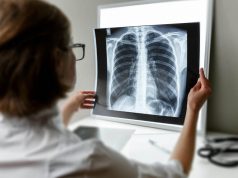
On Saturday, Prof Stanton Glantz published on his blog a compilation of scientific research papers to emphasize that e-cigarettes are, according to his own appreciation, “1/3 to 1/2 as bad as” traditional cigarettes. He carefully selected conclusions from each paper he cited, compiled them and assessed a risk level.

He also declared that “at least some of the short-term effects of e-cigarette use on these systems are comparable to cigarettes” before suggesting to agencies interested in public health to adopt his humble estimate rather than the “5% or lower” estimate of Public Health England and the British Royal College of physicians.
“well-written”, “cautiously interpreted”, “nice graphs”, “excellent discussion”
The bedrock of the professor’s argumentation for this risk estimate is a research paper [1] written by Aruni Bhatnagar from American Heart Association Tobacco Regulation and Addiction Center, Division of Cardiovascular Medicine of the Department of Medicine at the University of Louisville for whom Stanton Glantz cannot help praising the style: “well-written”; “cautiously interpreted”; “nice graphs”; “excellent discussion”.
The unifying thread that was used by Prof Glantz is the “nonlinear nature of the dose-response for cardiovascular disease“.
In his article Bhatnagar poses that the risk of cadiovascular disease (CVD) is not proportional to the number of cigarettes smoked by users and a CVD can affect smokers even at a lower level of harmful or potentially harmful chemical (HPHC) compared to lung cancers that generally declare after more chronic exposure. Bhatnagar also points out that the “CVD risk due to smoking can be reversed more rapidly than cancer risk“. Hence, the author suggests a decoupling between cancer causing and CVD causing substances in tobacco smoke.
Following Prof Glantz’ reasoning, decreasing cancer risk by using a non-combustible source of nicotine does not necessarily reduce the risk of CDV.
Does the dose-response non-linearity apply to acrolein toxicity?
In a publication on the Blog of Otago University quoted by Prof Glantz, the authors Wilson, Gartner and Edwards give a wiser advice:
“The safest option for smokers using vaping to reduce their health risk would be to limit the duration of dual use with cigarette smoking (ie, switching completely to vaping as soon as possible) and to also limit the total duration of vaping with a goal of reaching abstinence from both smoking and vaping, wherever possible without relapsing to smoking, which represents the greater risk to health.”
Professor Nick Wilson and Dr Coral Gartner recently issued a brief technical report entitled “Potential Range of Relative Harm from E-cigarettes for Major Health Conditions for use in Modelling Work: Based on Recent Biomarker Studies“, a biomarker study review that focuses on major toxicants that are likely to be associated with long-term conditions such as cancers and cardiovascular disease.
All suggest lower levels of risk for vapers compared to tobacco smokers but even a lower level of toxicity may represent a significant risk in a non-linear system, especially for formaldehyde and acrolein, as suggested by Prof Glantz who promptly anticipates larger effects on the cardiovascular function.

Dr Konstantinos Farsalinos, welcomes the methodological approach of Wilson and Gartner in a discussion of their publication on his Blog but also points out shortcomings that alter initial conclusions, especially for acrolein:
“The analysis by Wilson et al. should have concluded that as far as acrolein is concerned, the risk for disease among e-cigarette users is identical to non-smokers, and the relative-to-smoking risk is 0%. The results clearly show no acrolein exposure from e-cigarettes.”
The main reason is that acrolein is ubiquitously present in our environment and that evaluating acrolein metabolites in urine of smokers vs. non-smokers is inconclusive for risk evaluation. This also contradicts Prof Glantz in some of his deductions.
Does the dose-response non-linearity apply to epithelial cells’ defence?
Finally, a last point made by Prof Glantz is based on the results of a human study conducted by Prof Ilona Jaspers and published by Dr Elizabeth Martin (lead author) et al. [3], from the University of North Carolina at Chapel Hill. The authors studied the suppression of immune and inflammatory-response genes in nasal epithelial cells of smokers, vapers and non-smokers.

Where Prof S. Glantz sees in the decrease of gene expression in response of increasing amounts of volatile carbonyls, including formaldehyde, acrolein, and acetaldehyde (chemical products resulting from heating the propylene glycol and glycerine contained in e-liquids), the Director of the Institute for Internal Medicine and Clinical Immunology of the University of Catania in Italy, Prof Riccardo Polosa warns that “the observed association between e-cigarette use and changes in gene expression does not imply causation given the limitation of a cross-sectional design“.
“It is well known that exposure to cigarette smoke leads to alteration of non-coding RNA expression and function. Therefore, the observed suppression of a large number of genes in the vapers group is obviously related to their previous smoking history“, says the Italian researcher in a comment that he made to our redaction.
For Prof R. Polosa, the ideal would have been a longitudinal study and the inclusion of a group made of regular vapers who have never smoked in their life because previous exposure to tobacco smoking in the vapers group, basically ex-smokers, may have induced the irreversible epigenetic/gene expression. “Because the previous history of tobacco smoking exposure is so important in dictating epigenetic changes, some stratification for the pack/years (this parameter gives an estimate of the total amount a person has been exposed to cigarette smoke over the years and provides an idea of the overall risk related to tobacco use), between active smokers and vapers (i.e. ex-smokers) is mandatory to appropriately compare gene expression between vapers and smokers“.
The longitudinal approach “would have been more appropriate to establish potential causation of the effect of e-cigarette exposure on gene expression and related clinical implications (e.g. number of influenza infections).” suggests R. Polosa before adding that his comments had been submitted to the editorial board of the journal.
Contrasting with the hastily inferences of Prof Glantz, the meticulous review and constructive comments of physicians and researchers like Dr K. Farsalinos and Prof R. Polosa contribute to take the debate forward. In the war between “e-cigarette enthusiasts” and “e-cigarette doubters” it seems that true science marks some points against the Californian expert’s expectations.
It is important to note that no vaper have died so far from using an e-cigarette, that many smokers quit smoking and much more reduced their smoking with the help of personal vaporizers.
[1] Bhatnagar A., 2016. E-Cigarettes and Cardiovascular Disease Risk: Evaluation of Evidence, Policy Implications, and Recommendations. Current Cardiovascular Risk Reports, 10(7), 1-10.
[2] Carnevale R., Sciarretta S., Violi F., Nocella C., Loffredo L., Perri L., … & Valenti V., 2016. Acute impact of tobacco versus electronic cigarette smoking on oxidative stress and vascular function. Chestsmall
[3] Martin E., Clapp PW., Rebuli ME., Pawlak EA., Glista-Baker EE., Benowitz NL., … & Jaspers I., 2016. E-cigarette use results in suppression of immune and inflammatory-response genes in nasal epithelial cells similar to cigarette smoke. American Journal of Physiology-Lung Cellular and Molecular Physiology, ajplung-00170.












My cardiologist and my GP beg to differ with Professor Glantz.
he’s a toady of big pharma and big cancer. without smokers, both of those ‘bigs’ lose billions.
If Big Tobacco thinks about dropping combustible cigarettes in favor of harm reduction products (HNB or electronic cigarettes), what would Big Pharma promote? Smarties, Tic-Tac and peppermint candies?